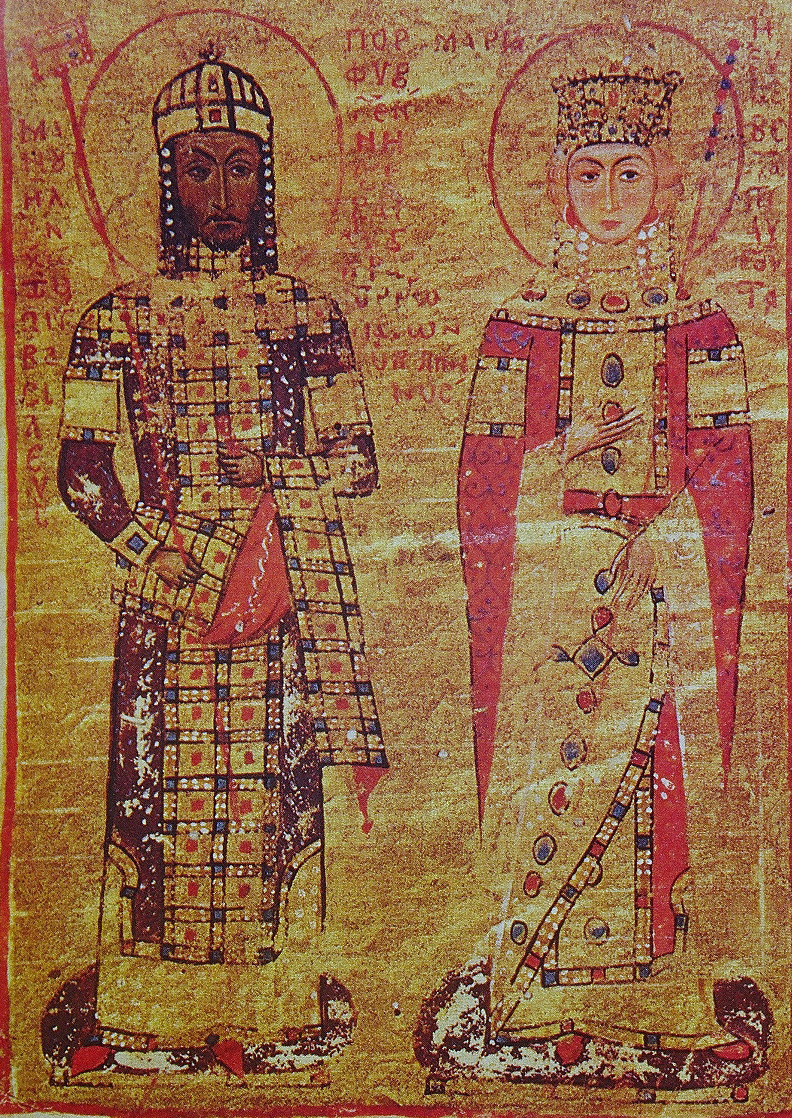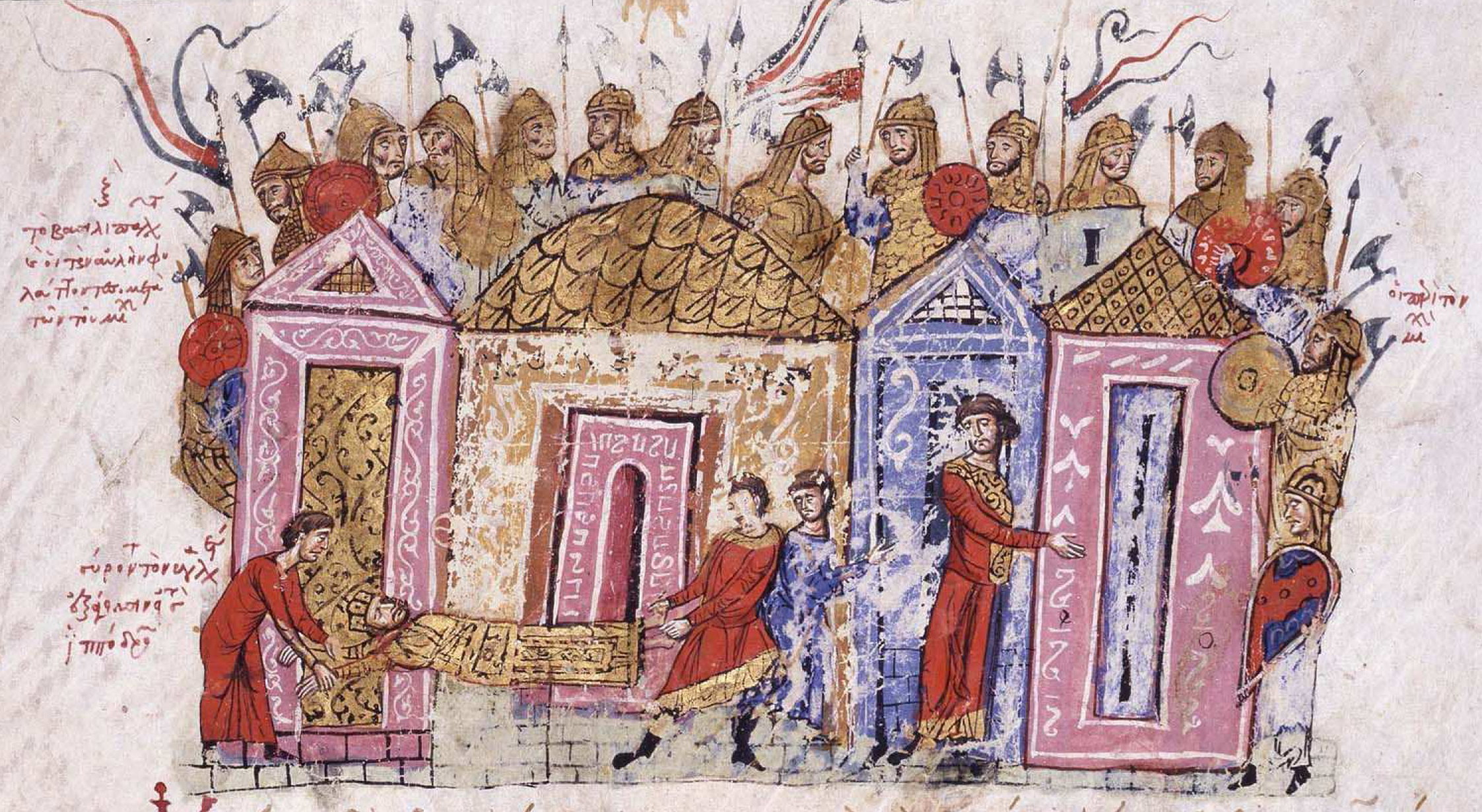|
Maria Of Antioch
Maria of Antioch (; 1145–1182) was a Byzantine empress by marriage to Byzantine Emperor Manuel I Komnenos, and regent during the minority of her son porphyrogennetos Alexios II Komnenos from 1180 until 1182. Early life Maria of Antioch was the daughter of Constance of Antioch and her first husband Raymond of Poitiers. In 1160, Maria's stepfather Raynald of Châtillon was taken prisoner by Maj al-Dīn, the ruler of Aleppo and an ally of Nūr al-Dīn. Her mother claimed the Principality of Antioch for herself, but the nobles supported her son, Maria's brother Bohemund III. King Baldwin III of Jerusalem set Bohemund III up as prince and appointed as regent the rich and worldly Aimery of Limoges, Latin Patriarch of Antioch and an old opponent of Raynald. Constance protested this decision in Constantinople at the court of the Byzantine emperor Manuel I Komnenos, the nominal overlord of Antioch. Byzantine empress At the end of 1159, Manuel's wife Empress Irene (origin ... [...More Info...] [...Related Items...] OR: [Wikipedia] [Google] [Baidu] |
Vatican Library
The Vatican Apostolic Library (, ), more commonly known as the Vatican Library or informally as the Vat, is the library of the Holy See, located in Vatican City, and is the city-state's national library. It was formally established in 1475, although it is much older—it is one of the oldest libraries in the world and contains one of the most significant collections of historical texts. It has 75,000 codex, codices from throughout history, as well as 1.1 million printed books, which include some 8,500 Incunabulum, incunabula. The Vatican Library is a research library for history, law, philosophy, science, and theology. The Vatican Library is open to anyone who can document their qualifications and research needs. Photocopies for private study of pages from books published between 1801 and 1990 can be requested in person or by mail. Pope Nicholas V (1447–1455) envisioned a new Rome, with extensive public works to lure pilgrims and scholars to the city to begin its transfor ... [...More Info...] [...Related Items...] OR: [Wikipedia] [Google] [Baidu] |
Principality Of Antioch
The Principality of Antioch (; ) was one of the Crusader states created during the First Crusade which included parts of Anatolia (modern-day Turkey) and History of Syria#Medieval era, Syria. The principality was much smaller than the County of Edessa or the Kingdom of Jerusalem. It extended around the northeastern edge of the Mediterranean Sea, Mediterranean, bordering the County of Tripoli to the south, Edessa to the east, and the Byzantine Empire or the Armenian Kingdom of Cilicia, Kingdom of Armenia to the northwest, depending on the date. It had roughly 20,000 inhabitants in the 12th century, most of whom were Armenians and Greek Orthodox Christians, with a few Muslims outside the Antioch city itself. Most of the crusaders who settled there were of Normans, Norman origin, notably from the Kingdom of Sicily, Norman Kingdom of southern Italy, as were the first rulers of the principality, who surrounded themselves with loyal subjects. Few of the inhabitants apart from the crus ... [...More Info...] [...Related Items...] OR: [Wikipedia] [Google] [Baidu] |
Melisende Of Tripoli
Melisende of Tripoli ( 1161) was a princess from the Latin East who was betrothed to the Byzantine emperor Manuel I Komnenos. She was the daughter of Hodierna of Jerusalem and Count Raymond II of Tripoli. Her cousin King Baldwin III of Jerusalem suggested her as the bride to the emperor, who agreed. Preparations were made for the marriage, and the nobility of the Latin East considered Melisende the future Byzantine empress. After long delays, however, the emperor declared that he would not marry Melisende. This severely affected Byzantine relations with the Latin East. Childhood Melisende was the younger of the two children of the count of Tripoli, Raymond II, and Hodierna of Jerusalem. Her older brother, Raymond III, was born in 1140. Melisende was named after her aunt Queen Melisende of Jerusalem, who was the older sister of Countess Hodierna. The marriage of Hodierna and Raymond fell apart because of Raymond's jealousy. Rumours circulated that Hodierna had been unfaith ... [...More Info...] [...Related Items...] OR: [Wikipedia] [Google] [Baidu] |
Jerusalem
Jerusalem is a city in the Southern Levant, on a plateau in the Judaean Mountains between the Mediterranean Sea, Mediterranean and the Dead Sea. It is one of the List of oldest continuously inhabited cities, oldest cities in the world, and is considered Holy city, holy to the three major Abrahamic religions—Judaism, Christianity, and Islam. Both Israel and Palestine claim Jerusalem as their capital city; Israel maintains its primary governmental institutions there, while Palestine ultimately foresees it as its seat of power. Neither claim is widely Status of Jerusalem, recognized internationally. Throughout History of Jerusalem, its long history, Jerusalem has been destroyed at least twice, Siege of Jerusalem (other), besieged 23 times, captured and recaptured 44 times, and attacked 52 times. According to Eric H. Cline's tally in Jerusalem Besieged. The part of Jerusalem called the City of David (historic), City of David shows first signs of settlement in the 4th ... [...More Info...] [...Related Items...] OR: [Wikipedia] [Google] [Baidu] |
Varangian Guard
The Varangian Guard () was an elite unit of the Byzantine army from the tenth to the fourteenth century who served as personal bodyguards to the Byzantine emperors. The Varangian Guard was known for being primarily composed of recruits from Northern Europe, including mainly Norsemen from Scandinavia but also Anglo-Saxons from England. The recruitment of distant foreigners from outside Byzantium to serve as the emperor's personal guard was pursued as a deliberate policy, as they lacked local political loyalties and could be counted upon to suppress revolts by disloyal Byzantine factions. The Rus' people, Rus' provided the earliest members of the Varangian Guard. They were in Byzantine service from as early as 874. The Guard was first formally constituted under Emperor Basil II in 988, following the Christianization of Kievan Rus' by Vladimir I of Kiev. Vladimir, who had recently taken control of Kiev with an army of Varangian warriors, sent 6,000 men to Basil as part of a military ... [...More Info...] [...Related Items...] OR: [Wikipedia] [Google] [Baidu] |
Akolouthos
''Akolouthos'' () was a Byzantine office with varying functions over time. Originally a subaltern officer of the imperial guard regiment ('' tagma'') of the '' Vigla'', it was associated with the command over the famed Varangian Guard in the 11th–12th centuries. History The title is first attested in the late 9th century, when the ''Kletorologion'' of 899 lists him as one of the senior officers of the '' Vigla'' or ''Arithmos'' guard regiment ('' tagma''). In the 9th–10th centuries, the ''akolouthos'' (often termed , ''akolouthos tou arithmou'', to emphasize his links to the ''Vigla''/''Arithmos'') was the deputy of the regimental commander, the '' droungarios tes vigles'', i.e. the equivalent of the ''proximos'' and the '' protomandator'' in the two senior ''tagmata'', the '' Scholai'' and the '' Excubitores''. Already at this time, however, he was associated with the command of the foreign mercenaries, chiefly the Franks. From the early 11th century, the ''droungarios tes ... [...More Info...] [...Related Items...] OR: [Wikipedia] [Google] [Baidu] |
Byzantine Aristocracy And Bureaucracy
Throughout the fifth century, Diadochi, Hellenistic-Eastern political systems, Ancient Greek philosophy, philosophies, and Theocracy, theocratic Christian concepts had gained power in the Greek-speaking Eastern Mediterranean due to the intervention of important religious figures there such as Eusebius, Eusebius of Caesarea () and Origen, Origen of Alexandria () who had been key to developing the constant Christianized worldview of late antiquity. By the 6th century, such ideas had already influenced the definitive power of the monarch as the Vicar of Christ, representative of God on earth and of his kingdom as an imitation of Kingdom of God (Christianity), God's holy realm. The Byzantine Empire was a multi-ethnic monarchy, monarchic theocracy adopting, following, and applying the Eastern Orthodox Church, Orthodox-Hellenistic kingdoms, Hellenistic political systems and Hellenistic philosophy, philosophies. The monarch was the incarnation of the law''nomos empsychos''and his power ... [...More Info...] [...Related Items...] OR: [Wikipedia] [Google] [Baidu] |
Crusader State
The Crusader states, or Outremer, were four Catholic polities established in the Levant region and southeastern Anatolia from 1098 to 1291. Following the principles of feudalism, the foundation for these polities was laid by the First Crusade, which was proclaimed by the Latin Church in 1095 in order to reclaim the Holy Land after it was lost to the 7th-century Muslim conquest. From north to south, they were: the County of Edessa (10981150), the Principality of Antioch (10981268), the County of Tripoli (11021289), and the Kingdom of Jerusalem (10991291). The three northern states covered an area in what is now southeastern Turkey, northwestern Syria, and northern Lebanon; the Kingdom of Jerusalem, the southernmost and most prominent state, covered an area in what is now Israel, Palestine, southern Lebanon, and western Jordan. The description "Crusader states" can be misleading, as from 1130 onwards, very few people among the Franks were Crusaders. Medieval and modern writers ... [...More Info...] [...Related Items...] OR: [Wikipedia] [Google] [Baidu] |
Bertha Of Sulzbach
Bertha of Sulzbach (1110s – 1160), also known as Irene, was a Byzantine empress by marriage to Byzantine Emperor Manuel I Komnenos. Life She was born in Sulzbach, a daughter of Berengar II, Count of Sulzbach (c. 1080 – 3 December 1125) and his second spouse Adelheid of Wolfratshausen. He was one of the rulers who signed the Concordat of Worms. Empress Emissaries of the Byzantine emperor John II Komnenos arrived in Germany, seeking an alliance against Roger II of Sicily. To seal the alliance, the emissaries requested that Conrad send a princess of his family to be married to the emperor's son, Manuel. Instead, Conrad selected his sister-in-law, Bertha, and after legally adopting her as his daughter, sent her to the Byzantine Empire escorted by Emicho von Leiningen, the Bishop of Würzburg. By the time Bertha arrived at the Imperial court in Constantinople, the emperor John was dead, and his son Manuel was now the reigning emperor. Manuel delayed marrying her for three ... [...More Info...] [...Related Items...] OR: [Wikipedia] [Google] [Baidu] |
Constantinople
Constantinople (#Names of Constantinople, see other names) was a historical city located on the Bosporus that served as the capital of the Roman Empire, Roman, Byzantine Empire, Byzantine, Latin Empire, Latin, and Ottoman Empire, Ottoman empires between its consecration in 330 until 1930, when it was renamed to Istanbul. Initially as New Rome, Constantinople was founded in 324 during the reign of Constantine the Great on the site of the existing settlement of Byzantium, and shortly thereafter in 330 became the capital of the Roman Empire. Following the collapse of the Western Roman Empire in the late 5th century, Constantinople remained the capital of the Eastern Roman Empire (also known as the Byzantine Empire; 330–1204 and 1261–1453), the Latin Empire (1204–1261), and the Ottoman Empire (1453–1922). Following the Turkish War of Independence, the Turkish capital then moved to Ankara. Although the city had been known as Istanbul since 1453, it was officially renamed as Is ... [...More Info...] [...Related Items...] OR: [Wikipedia] [Google] [Baidu] |
Latin Patriarch Of Antioch
Antioch on the Orontes (; , ) "Antioch on Daphne"; or "Antioch the Great"; ; ; ; ; ; ; . was a Hellenistic Greek city founded by Seleucus I Nicator in 300 BC. One of the most important Greek cities of the Hellenistic period, it served as the capital of the Seleucid Empire and later as regional capital to both the Roman and Byzantine Empire. During the Crusades, Antioch served as the capital of the Principality of Antioch, one of four Crusader states that were founded in the Levant. Its inhabitants were known as ''Antiochenes''. The remains of the ancient city of Antioch are mostly buried beneath alluvial deposits from the Orontes River. The modern city of Antakya, in Hatay Province of Turkey, lies in its place. Antioch was founded near the end of the fourth century BC by Seleucus I Nicator, one of Alexander the Great's generals, as one of the tetrapoleis of Seleucis of Syria. Seleucus encouraged Greeks from all over the Mediterranean to settle in the city. The city's ... [...More Info...] [...Related Items...] OR: [Wikipedia] [Google] [Baidu] |







